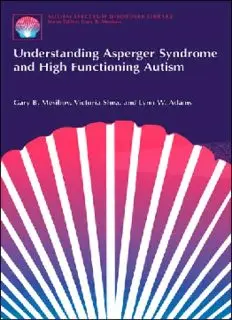Table Of ContentUnderstanding
Asperger Syndrome
and High Functioning
Autism
Autism Spectrum Disorders Library
Series Editor: Gary B. Mesibov
UNDERSTANDING ASPERGER SYNDROME AND HIGH
FUNCTIONING AUTISM
Gary B. Mesibov, Victoria Shea, and Lynn W. Adams
AContinuationOrderPlanisavailableforthisseries. Acontinuationorderwillbringdelivery
of each newvolume immediately upon publication. Volumesarebilled only upon actual
shipment. Forfurtherinformationpleasecontactthepublisher.
Understanding
Asperger Syndrome
and High Functioning
Autism
Gary B. Mesibov and
Victoria Shea
University of North Carolina
ChapelHill,NorthCarolina
and
Lynn W. Adams
Mercy Family Center
NewOrleans, Louisiana
KLUWER ACADEMIC PUBLISHERS
NEW YORK, BOSTON, DORDRECHT, LONDON, MOSCOW
eBookISBN: 0-306-47679-7
Print ISBN: 0-306-46626-0
©2002 Kluwer Academic Publishers
NewYork, Boston, Dordrecht, London, Moscow
Print ©2001 Kluwer Academic/Plenum Publishers
New York
All rights reserved
No part of this eBook may be reproduced ortransmitted in any form or by any means, electronic,
mechanical, recording, or otherwise, without written consent from the Publisher
Created in the United States of America
Visit Kluwer Online at: http://kluweronline.com
and Kluwer's eBookstoreat: http://ebooks.kluweronline.com
Preface
This volume is designed to provide an overview of Asperger’s
Syndrome/High Functioning Autism for professionals, parents, and
others concerned about these conditions. It is part of the library series
that has been created for the many people interested in the field of
autism spectrum disorders who want up-to-date, authoritative informa-
tion without having to locate and read through the original sources.
Our goal in this series is to review, synthesize, and organize the infor-
mation so that it can be presented comprehensively and clearly.
This volume is the culmination of over a decade of clinical work
identifying, organizing, writing, and editing the most current informa-
tion available about this high functioning group of people with autism
spectrum disorders from current reputable sources. The book explores
the history and emphasizes the diagnosis, assessment, and treatment of
these people and their families. We hope that we have done justice to
this extensive literature so that it can be of use to these people them-
selves as well as to their many friends,colleagues, and families, and to
the interested citizens who are seeking more information about this
intriguing area of inquiry.
V
Acknowledgments
We are indebted to many people for their help on this project,
and we want to acknowledge their substantial contributions. First and
foremost we want to thank our TEACCH colleagues and the many
families and professionals who have worked with us. Their interest in
our views, perceptive comments about HFA/AS, their support, and
their assistance have been invaluable. There are many exciting and
rewarding aspects of living and working in North Carolina, but most
important are the terrific people we meet and work with.
Joan Berry has been particularly important throughout this pro-
ject, typing numerous drafts, changes, corrections, and insertions. She
has done all of this work with a smile on her face and her usual accu-
racy and efficiency. Leia Grossman, a student research assistant, did
many of the mundane tasks that are so essential for an accurate and
comprehensive final product. Her assistance in tracking down and
checking references has added immeasurably to this final product.
Finally, as with all our projects collaborating with Kluwer, our
editor, Mariclaire Cloutier, has to be thanked for her responsiveness,
assistance, and all-around excellence. Her patience as we wrote and
rewrote the final drafts is especially appreciated.
Finally, our friends, families, and colleagues are to be thanked
for enduring our absence as we worked the demanding schedule that a
project like this requires. Their interest and understanding made all of
this bearable, even during the most intense periods of working on this
manuscript. Special thanks are due to Joan Goodrich Lang for her
ongoing interest and support.
vii
Contents
1. Asperger Syndrome/High Functioning Autism 1
Introduction 3
History 5
Kanner’s Original Paper 6
Asperger’s Original Paper 7
Similarities Between Kanner and Asperger 9
Biases, Cultural Norms, and Referral Samples 10
Differences Between Kanner’s
and Asperger’s Descriptions 12
Other Names for Similar Groups 13
Asperger Syndrome BeforeWing’s Paper 15
Wing’s Contributions 17
Other Early Reports of Higher Functioning Autism 20
The Role of the DSM 21
Summary and Conclusion 22
2. Diagnosis and Classification 25
Introduction 25
Common Elements in DSM-IV Criteria for
Asperger Syndrome and Autism 27
Qualitative Impairment in Reciprocal
Social Interaction 27
Restricted Repetitive and Stereotyped Patterns of Behavior,
Interests, and Activities 29
Primary Difference in DSM-IV Criteria for
Asperger Syndrome and Autism 30
Additional Aspects of AS in DSM-IV 32
ix
x Contents
CurrentPerspectives on the Relationship of
Autism and AS 34
Diagnosis of Related Disorders 38
Obsessive–Compulsive Disorder (OCD) 38
Semantic–Pragmatic Disorder 39
Schizoid Personality Disorder 40
Nonverbal Learning Disability (NLD) 41
Pervasive Developmental Disorder–
Not Otherwise Specified (PDD-NOS) 42
Summary and Conclusion 43
3. Psychological Assessment of Asperger Syndrome 45
Introduction 46
Goals of Psychological Assessment 47
Diagnosis 47
Intervention Planning 48
Psychological Assessment Procedures 49
Parent Interviews 49
Observation and Informal Interviews 50
Formal Testing 51
Summary of Recommendations for Assessment 68
After the Assessment 69
Summary and Conclusions 69
Appendix 69
Cognitive Tests 70
Academic Achievement Tests 70
Adaptive Behavior Tests 70
Checklists and Rating Scales 71
Tests of Executive Function 71
Other Tests 72
4. Interventions 73
Introduction 73
Theoretical Foundations of the TEACCH Structured
Teaching Method for Autism Spectrum Disorders 74
UnderstandingAutismSpectrum Disorders 74
Contents xi
Individual Observation and Planning 75
Implications of AS/HFA for Designing Interventions 76
Additional Principles of Intervention 83
Age-Specific Interventions 85
Social Issues 88
Academic Issues 94
Behavior Problems and Emotional Issues 101
Transition to Adulthood 103
Research Literature 105
Summary and Conclusion 107
Additional Resources 107
Appendix 107
Outline of a Social Story Explaining AS/HFA 107
5. Final Thoughts 109
The Autism Spectrum 109
Divisions Within the AutismSpectrum 109
What Is in a Name? 112
Epilogue 113
References 115
Index 125

